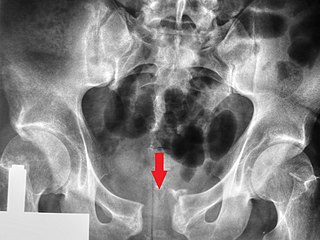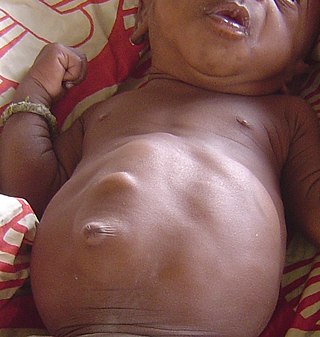Related Research Articles

Pathology is the study of disease and injury. The word pathology also refers to the study of disease in general, incorporating a wide range of biology research fields and medical practices. However, when used in the context of modern medical treatment, the term is often used in a narrower fashion to refer to processes and tests that fall within the contemporary medical field of "general pathology", an area that includes a number of distinct but inter-related medical specialties that diagnose disease, mostly through analysis of tissue and human cell samples. Idiomatically, "a pathology" may also refer to the predicted or actual progression of particular diseases, and the affix pathy is sometimes used to indicate a state of disease in cases of both physical ailment and psychological conditions. A physician practicing pathology is called a pathologist.
A diastase is any one of a group of enzymes that catalyses the breakdown of starch into maltose. For example, the diastase α-Amylase degrades starch to a mixture of the disaccharide maltose; the trisaccharide maltotriose, which contains three α (1-4)-linked glucose residues; and oligosaccharides, known as dextrins, that contain the α (1-6)-linked glucose branches.

Forensic pathology is pathology that focuses on determining the cause of death by examining a corpse. A post mortem examination is performed by a medical examiner or forensic pathologist, usually during the investigation of criminal law cases and civil law cases in some jurisdictions. Coroners and medical examiners are also frequently asked to confirm the identity of remains.

The pubic symphysis is a secondary cartilaginous joint between the left and right superior rami of the pubis of the hip bones. It is in front of and below the urinary bladder. In males, the suspensory ligament of the penis attaches to the pubic symphysis. In females, the pubic symphysis is close to the clitoris. In most adults it can be moved roughly 2 mm and with 1 degree rotation. This increases for women at the time of childbirth.

Serum is the fluid and solute component of blood which does not play a role in clotting. It may be defined as blood plasma without the clotting factors, or as blood with all cells and clotting factors removed. Serum includes all proteins not used in blood clotting; all electrolytes, antibodies, antigens, hormones; and any exogenous substances. Serum does not contain white blood cells (leukocytes), red blood cells (erythrocytes), platelets, or clotting factors.

Beckwith–Wiedemann syndrome is an overgrowth disorder usually present at birth, characterized by an increased risk of childhood cancer and certain congenital features. A minority (<15%) of cases of BWS are familial, meaning that a close relative may also have BWS, and parents of an affected child may be at increased risk of having other children with BWS. While children with BWS are at increased risk of childhood cancer, most children with BWS do not develop cancer and the vast majority of children who do develop cancer can be treated successfully.

A symphysis is a fibrocartilaginous fusion between two bones. It is a type of cartilaginous joint, specifically a secondary cartilaginous joint.
- A symphysis is an amphiarthrosis, a slightly movable joint.
- A growing together of parts or structures.

Daidzein is a naturally occurring compound found exclusively in soybeans and other legumes and structurally belongs to a class of compounds known as isoflavones. Daidzein and other isoflavones are produced in plants through the phenylpropanoid pathway of secondary metabolism and are used as signal carriers, and defense responses to pathogenic attacks. In humans, recent research has shown the viability of using daidzein in medicine for menopausal relief, osteoporosis, blood cholesterol, and lowering the risk of some hormone-related cancers, and heart disease. Despite the known health benefits, the use of both puerarin and daidzein is limited by their poor bioavailability and low water solubility.
Sir Charles Robert Harington, KBE, FRS was a chemist, best known for synthesising thyroxine.
Diastasis may refer to:

In physiology, diastasis is the middle stage of diastole during the cycle of a heartbeat, where the initial passive filling of the heart's ventricles has slowed, but before the atria contract to complete the active filling. Diastasis is the longest phase of cardiac cycle.

Pubic symphysis diastasis is the separation of normally joined pubic bones, as in the dislocation of the bones, without a fracture that measures radiologically more than 10 mm. Separation of the symphysis pubis is a rare pathology associated with childbirth and has an incidence of 1 in 300 to 1 in 30,000 births. It is usually noticed after delivery but can be observed up to six months postpartum. Risk factors associated with this injury include cephalopelvic disproportion, rapid second stage of labor, epidural anesthesia, severe abduction of the thighs during delivery, or previous trauma to the pelvis. Common signs and symptoms include symphyseal pain aggravated by weight-bearing and walking, a waddling gait, pubic tenderness, and a palpable interpubic gap. Treatment for pubic symphysis diastasis is largely conservative, with treatment modalities including pelvic bracing, bed rest, analgesia, physical therapy, and in some severe cases, surgery.

Diastasis recti, or rectus abdominis diastasis, is defined as a gap of about 2.7 cm or greater between the two sides of the rectus abdominis muscle. The distance between the right and left rectus abdominis muscles is created by the stretching of the linea alba, a connective collagen sheath created by the aponeurosis insertions of the transverse abdominis, internal oblique, and external oblique. This condition has no associated morbidity or mortality. Physical therapy is often required to repair this separation and surgery is an option for more severe cases. Standard exercise rarely results in complete healing of the separated muscles.
A dental school is a tertiary educational institution—or part of such an institution—that teaches dental medicine to prospective dentists and potentially other dental auxiliaries. Dental school graduates receive a degree in Dentistry, Dental Surgery, or Dental Medicine, which, depending upon the jurisdiction, might be a bachelor's degree, master's degree, a professional degree, or a doctorate. Schools can also offer postgraduate training in general dentistry, and/or training in endodontics, oral and maxillofacial surgery, oral pathology, oral and maxillofacial radiology, orthodontics, pedodontics, periodontics, prosthodontics, dental public health, restorative dentistry, as well as postgraduate training for dental hygienists and dental technicians.

Macrostomia refers to a mouth that is unusually wide. The term is from the Greek prefix makro- meaning "large" and from Greek στόμα, "mouth".
A presystolic murmur, also called presystolic accentuation, is a type of diastolic heart murmur typically associated with the opening snap in mitral valve stenosis. It is heard following the middiastolic rumble of the stenotic valve, during the diastasis phase, making it a "late diastolic" murmur.

Magical Battle Arena is a crossover third-person shooter game developed by Fly-System in 2008. The game features characters from Magical Girl Lyrical Nanoha, Magic Knight Rayearth, Cardcaptor Sakura, Slayers, and Mahōjin Guru Guru.
Divaricate means branching, or having separation or a degree of separation. The angle between branches is wide.
Sir Roderick Norman McIver MacSween was a Scottish pathologist, professor of pathology at University of Glasgow, 1984 to 1999.
Signs and symptoms of pregnancy are common, benign conditions that result from the changes to the body that occur during pregnancy. Signs and symptoms of pregnancy typically change as pregnancy progresses, although several symptoms may be present throughout. Depending on severity, common symptoms in pregnancy can develop into complications. Pregnancy symptoms may be categorized based on trimester as well as region of the body affected.
References
- ↑ Pekka J. Saukko; Bernard Knight (January 2004). Knight's Forensic Pathology. CRC Press. pp. 188–. ISBN 978-0-340-76044-4 . Retrieved 2013-08-06.